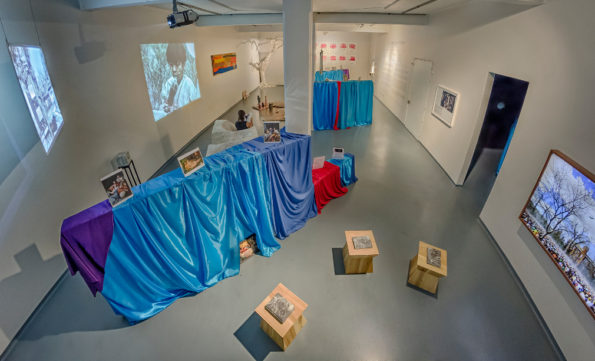Search
To search for an exact match, type the word or phrase you want in quotation marks.
A*DESK has been offering since 2002 contents about criticism and contemporary art. A*DESK has become consolidated thanks to all those who have believed in the project, all those who have followed us, debating, participating and collaborating. Many people have collaborated with A*DESK, and continue to do so. Their efforts, knowledge and belief in the project are what make it grow internationally. At A*DESK we have also generated work for over one hundred professionals in culture, from small collaborations with reviews and classes, to more prolonged and intense collaborations.
At A*DESK we believe in the need for free and universal access to culture and knowledge. We want to carry on being independent, remaining open to more ideas and opinions. If you believe in A*DESK, we need your backing to be able to continue. You can now participate in the project by supporting it. You can choose how much you want to contribute to the project.
You can decide how much you want to bring to the project.

Reflecting on drugs in Mexico means confronting a multifaceted phenomenon that is hard to encompass. After all these substances acquire a huge diversity of meanings for Mexicans: perceived by certain sectors of local society as a serious social and health problem, they are vindicated by others as a response mechanism and symbol of liberty. Often used for recreational ends, amongst certain ethnic groups they acquire a profound religious meaning. with an extraordinary ritualistic importance, as happens with grass amongst the Mazatecs or peyote amongst the Huicholes. Drugs are also a powerful economic motor, capable of employing abundant manual labour –from farmers to dealers, passing through mules, hit-men, and musicians– disproportionately enriching the big drug cartels, as evidenced by the figure of Joaquín, el Chapo, Guzman, the main leader of the Sinaloa cartel, who between 2009 and 2012 formed part of Forbes magazine’s list of richest men in the world. In the end, drugs are an extraordinarily powerful tool, capable of influencing in a determinant manner the agenda of the country’s governing class and infiltrating the most diverse strata of the public administration, to the degree of converting Mexican politics into narco-politics or to put it another way, psychotropic politics.
The exhibition Los comedores de loto, revolves around drugs and its imaginaries, the exhibition is open to the public, until the 28 July, in the Casa del Lago in Mexico City. It’s one of the most interesting exhibitions to see this season in the Mexican capital. Inspired in a landscape from ‘L’Odissea’ that narrates how Ulysses’ men, having been driven by the storm to the island of the lotus-eaters, succumb to the pleasures of a narcotic plant, the exhibition brings together a wide variety of works that consider, from different perspectives, the phenomenon of substances that are capable of altering our sensory perception.
Los comedores de loto seems like an amalgam of heterogeneous pieces– the work of creators as diverse as Rosemarie Trockel, Jimena Mendoza, Aníbal Delgado, Mark Leffingwell and Enrique Minjares, amongst others– that includes not just artistic projects but also ethnographic material, pieces of furniture and graphic design proposals, with the idea of offering a kaleidoscopic vision of the universe of drugs.
It is the interdisciplinary character of the exhibition in particular that is emphasised by its special lay out, which juxtaposes different proposals in an undifferentiated magma, that aims to dissolve generic and stylistic hierarchies. The proposals intermingle in the exhibition space, as if, at least in appearance, they had been abandoned there by chance. Cool ethnographic documents are combined with paintings with a psychedelic feel; comfortable sofas evocative of the experience of narcosis share the space with books from the Biblioteca Cannábica; conceptual art proposals intermingle with works of a journalistic nature. In this way, the rooms of the Casa del Lago become a hybrid environment, halfway between a space for contemplation, a recreational space and a centre of documentation.
In fact, the show’s particular lay out ends up eroding the very concept of authorship, by eliminating all reference to the individual creators. The captions for each work are conspicuous for their absence in the exhibition space, so that it ends up being almost impossible to link each of the proposals with a specific author. This fact, along with the lack of any hierarchical organisation of the pieces that make up the show, leaves the spectator to perceive Los comedores de loto as a sort of collective body and no longer as the sum of diverse individual works.
Los comedores de loto seeks to bring us closer to the imaginary of drugs, submerging us in an atmosphere that is somewhat oneiric and hallucinatory. Its aim is not to offer an objective vision of stupefying substances but to introduce us into their reality, through suggestions and allusions to the sensory states that they provoke. And in this sense, it effectively achieves this aim.
That said, this exhibition still displays a weak side: the condescendence that it shows regarding the situation of violence provoked by drug trafficking in Mexico. This is a problem that profoundly marks the political agenda and life of Mexicans. It’s a subject that, on the one hand, has led to powerful art images, such as the cards used to cut cocaine illustrated with images of the victims of drug-dealing crime, by Teresa Margolles. But the violence provoked by drug-traffickers is a question that can’t be avoided in an exhibition dedicated to drugs. It’s a pity that Los comedores de loto, an almost entirely successful show, sidesteps the issue.

Eduardo Pérez Soler thinks that art –like Buda– is dead, though its shadow is still projected on the cave. However, this lamentable fact doesn´t impede him from continuing to reflect, discuss and write about the most diverse forms of creation.
"A desk is a dangerous place from which to watch the world" (John Le Carré)